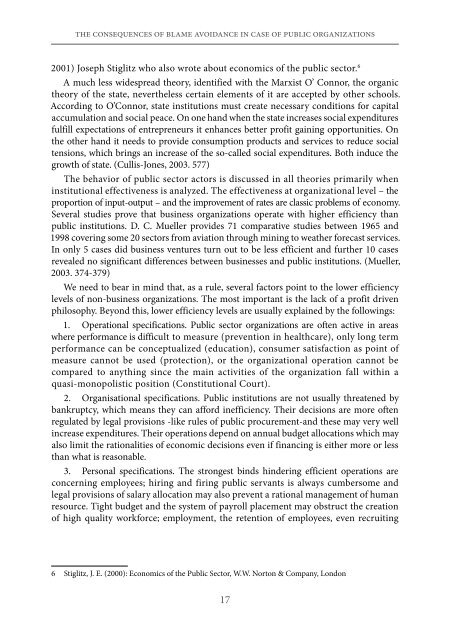ACTA SZEKSZARDIENSIUM - Pécsi Tudományegyetem Illyés Gyula ...
ACTA SZEKSZARDIENSIUM - Pécsi Tudományegyetem Illyés Gyula ...
ACTA SZEKSZARDIENSIUM - Pécsi Tudományegyetem Illyés Gyula ...
Create successful ePaper yourself
Turn your PDF publications into a flip-book with our unique Google optimized e-Paper software.
the consequences of blame avoidance in case of public organizations<br />
2001) Joseph Stiglitz who also wrote about economics of the public sector. 6<br />
A much less widespread theory, identified with the Marxist O’ Connor, the organic<br />
theory of the state, nevertheless certain elements of it are accepted by other schools.<br />
According to O’Connor, state institutions must create necessary conditions for capital<br />
accumulation and social peace. On one hand when the state increases social expenditures<br />
fulfill expectations of entrepreneurs it enhances better profit gaining opportunities. On<br />
the other hand it needs to provide consumption products and services to reduce social<br />
tensions, which brings an increase of the so-called social expenditures. Both induce the<br />
growth of state. (Cullis-Jones, 2003. 577)<br />
The behavior of public sector actors is discussed in all theories primarily when<br />
ins titutional effectiveness is analyzed. The effectiveness at organizational level – the<br />
proportion of input-output – and the improvement of rates are classic problems of economy.<br />
Several studies prove that business organizations operate with higher efficiency than<br />
public institutions. D. C. Mueller provides 71 comparative studies between 1965 and<br />
1998 covering some 20 sectors from aviation through mining to weather forecast services.<br />
In only 5 cases did business ventures turn out to be less efficient and further 10 cases<br />
revealed no significant differences between businesses and public institutions. (Mueller,<br />
2003. 374-379)<br />
We need to bear in mind that, as a rule, several factors point to the lower efficiency<br />
levels of non-business organizations. The most important is the lack of a profit driven<br />
philosophy. Beyond this, lower efficiency levels are usually explained by the followings:<br />
1. Operational specifications. Public sector organizations are often active in areas<br />
where performance is difficult to measure (prevention in healthcare), only long term<br />
performance can be conceptualized (education), consumer satisfaction as point of<br />
measure cannot be used (protection), or the organizational operation cannot be<br />
compared to anything since the main activities of the organization fall within a<br />
quasi-monopolistic position (Constitutional Court).<br />
2. Organisational specifications. Public institutions are not usually threatened by<br />
bankruptcy, which means they can afford inefficiency. Their decisions are more often<br />
regulated by legal provisions -like rules of public procurement-and these may very well<br />
increase expenditures. Their operations depend on annual budget allocations which may<br />
also limit the rationalities of economic decisions even if financing is either more or less<br />
than what is reasonable.<br />
3. Personal specifications. The strongest binds hindering efficient operations are<br />
concerning employees; hiring and firing public servants is always cumbersome and<br />
legal provisions of salary allocation may also prevent a rational management of human<br />
resource. Tight budget and the system of payroll placement may obstruct the creation<br />
of high quality workforce; employment, the retention of employees, even recruiting<br />
6 Stiglitz, J. E. (2000): Economics of the Public Sector, W.W. Norton & Company, London<br />
17




